Amorphophallus titanum
Amorphophallus titanum, the titan arum, is a flowering plant with the largest unbranched inflorescence in the world. The talipot palm, Corypha umbraculifera, has a larger inflorescence, but it is branched rather than unbranched. Amorphophallus titanum is endemic to Sumatra.
| Amorphophallus titanum | |
|---|---|
_-_2.jpg.webp) | |
| In bloom at New York Botanical Garden June 27, 2018 | |
| Scientific classification | |
| Kingdom: | Plantae |
| Clade: | Tracheophytes |
| Clade: | Angiosperms |
| Clade: | Monocots |
| Order: | Alismatales |
| Family: | Araceae |
| Genus: | Amorphophallus |
| Species: | A. titanum |
| Binomial name | |
| Amorphophallus titanum (Becc.) Becc. ex Arcang | |
| Synonyms | |
| |
Due to its odor, like that of a rotting corpse, the titan arum is characterized as a carrion flower, and is also known as the corpse flower or corpse plant (Indonesian: bunga bangkai—bunga means flower, while bangkai can be translated as corpse, cadaver, or carrion).
The titan arum's berries arrange in a regular cylindrical form that resemble the packing of spheres inside a cylindrical confinement. Those structures are also called columnar structures or crystals.
Etymology
Amorphophallus titanum derives its name from Ancient Greek (άμορφος – amorphos, "without form, misshapen" + φαλλός – phallos, "phallus", and titan, "giant"). The popular name "titan arum" was coined by W.H. Hodge.[2]
Description
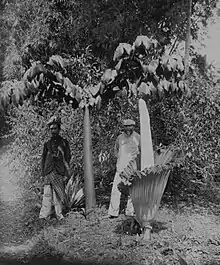
The titan arum's inflorescence can reach over 3 metres (10 ft) in height. Like the related cuckoo pint and calla lily, it consists of a fragrant spadix of flowers wrapped by a spathe, which looks like a large petal. In the case of the titan arum, the spathe is a deep green on the outside and dark burgundy red on the inside, with a deeply furrowed texture. The spadix is hollow and resembles a large baguette. Near the bottom of the spadix, hidden from view inside the sheath of the spathe, the spadix bears two rings of small flowers. The upper ring bears the male flowers, the lower ring is spangled with bright red-orange carpels. The "fragrance" of the titan arum resembles rotting meat, attracting carrion-eating beetles and flesh flies (family Sarcophagidae) that pollinate it. The inflorescence's deep red color and texture contribute to the illusion that the spathe is a piece of meat. During bloom, the tip of the spadix is approximately human body temperature, which helps the perfume volatilize; this heat is also believed to assist in the illusion that attracts carcass-eating insects.
Both male and female flowers grow in the same inflorescence. The female flowers open first, then a day or two following, the male flowers open. This usually prevents the flower from self-pollinating.
After the flower dies back, a single leaf, which reaches the size of a small tree, grows from the underground corm. The leaf grows on a somewhat green stalk that branches into three sections at the top, each containing many leaflets. The leaf structure can reach up to 6 m (20 ft) tall and 5 m (16 ft) across. Each year, the old leaf dies and a new one grows in its place. When the corm has stored enough energy, it becomes dormant for about four months. Then the process repeats.
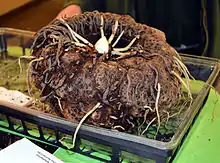
The corm is the largest known, typically weighing around 50 kg (110 lb).[3] When a specimen at the Princess of Wales Conservatory, Kew Gardens, was repotted after its dormant period, the weight was recorded as 91 kg (201 lb).[4] In 2006, a corm in the Botanical Garden of Bonn, Germany was recorded at 117 kg (258 lb),[5] and an A. titanum grown in Gilford, New Hampshire by Dr. Louis Ricciardiello in 2010 weighed 138 kg (305 lb).[6][7] However, the current record is held by a corm grown at the Royal Botanic Garden Edinburgh, weighing 153.9 kg (339 lb) after 7 years' growth from an initial corm the size of an orange.[8]
Distribution
Amorphophallus titanum is native solely to western Sumatra,[1] where it grows in openings in rainforests on limestone hills.[9] However, the plant is cultivated by botanical gardens and private collectors around the world.[1]
Cultivation
The titan arum grows in the wild only in the equatorial rainforests of Sumatra, Indonesia. It was first scientifically described in 1878 by Italian botanist Odoardo Beccari. The plant flowers only infrequently in the wild. It first flowered in cultivation at the Royal Botanic Gardens, Kew, London, UK in 1889, with over one hundred cultivated blossoms since then. The first documented flowerings in the United States were at the New York Botanical Garden in 1937 and 1939. This flowering also inspired the designation of the titan arum as the official flower of the Bronx in 1939, only to be replaced in 2000 by the day lily. The number of cultivated plants has increased in recent years, and it is not uncommon for there to be five or more flowering events in gardens around the world in a single year. Advanced pollination techniques mean that this plant is rarely cultivated by amateur gardeners. However, in 2011, Roseville High School (Roseville, California) became the first high school in the world to bring a titan arum to bloom.[10]
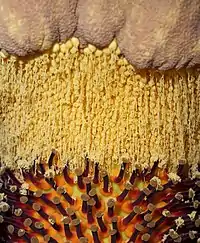
In 2003, the tallest bloom in cultivation, some 2.74 m (9 ft 0 in) high, was achieved at the Botanical Garden of the University of Bonn in Germany. The event was acknowledged by Guinness World Records.[11] In 2005 this record was broken at the botanical and zoological garden Wilhelma in Stuttgart, Germany; the bloom reached a height of 2.94 m (9 ft 8 in). The record was broken again by Louis Ricciardiello, whose specimen measured 3.1 m (10 ft 2 in) tall in 2010, when it was on display at Winnipesaukee Orchids in Gilford, New Hampshire, US. This event, too, was acknowledged by Guinness World Records.[12][13]
Blooming
See also List of publicised titan arum blooms in cultivation
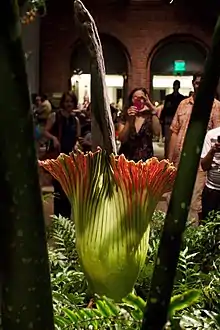
In cultivation, the titan arum generally requires 7 to 10 years of vegetative growth before blooming for the first time. After its initial blooming, there can be considerable variation in blooming frequency. Some plants may not bloom again for another 7 to 10 years while others may bloom every two to three years. A plant has been flowering every second year (2014,16, 18 and 2020) in the Botanical Garden in Copenhagen. [14] There have also been documented cases of back-to-back blooms occurring within a year[15] and corms simultaneously sending up both a leaf (or two) and an inflorescence.[16] There has also been an occasion when a corm produced multiple simultaneous blooms.[17]
The spathe generally begins to open between mid-afternoon[18] and late evening and remains open all night. At this time, the female flowers are receptive to pollination. Although most spathes begin to wilt within twelve hours, some have been known to remain open for 24 to 48 hours. As the spathe wilts, the female flowers lose receptivity to pollination.
Self-pollination was once considered impossible, but in 1999, Huntington Botanical Garden botanists hand-pollinated their plant with its own pollen from ground-up male flowers. The procedure was successful, resulting in fruit and ten fertile seeds from which several seedlings were eventually produced.[19] Additionally, a titan arum at Gustavus Adolphus College, in Minnesota, unexpectedly produced viable seed through self-pollination in 2011.[20]
Odor
As the spathe gradually opens, the spadix releases powerful odors to attract pollinators, insects which feed on dead animals or lay their eggs in rotting meat. The potency of the odor gradually increases from late evening until the middle of the night, when carrion beetles and flesh flies are active as pollinators, then tapers off towards morning.[21] Analyses of chemicals released by the spadix show the stench includes dimethyl trisulfide (like limburger cheese), dimethyl disulfide, trimethylamine (rotting fish), isovaleric acid (sweaty socks), benzyl alcohol (sweet floral scent), phenol (like Chloraseptic), and indole (like feces).[22][23]
Videos
Live-feed video
- Rosie, began blooming Monday, April 23, 2018 at the Tucson Botanical Gardens in Tucson, AZ[24][25]
- Octavia, the eighth corpse flower to bloom in five years at the Missouri Botanical Garden, began blooming on July 9, 2017.[26]
- Kansas State University Gardens began blooming Tuesday June 27, 2017 in Manhattan, KS
- Little Dougie, bloom started Wednesday May 28, 2017 at Orange Coast College in Costa Mesa, CA[27]
- Audrey, began blooming Monday June 26, 2017 at California Carnivores in Sebastopol, CA[28]
- Terra, began blooming Thursday, June 15, 2017 at the Conservatory of Flowers in San Francisco.[29]
- Java and Sumatra, began blooming Wednesday, May 31, 2017 at Chicago Botanic Garden in Glencoe, IL.[30]
- Wee Stinky, titan arum bloom, began blooming Friday, October 14, 2016 at Cornell University in Ithaca, New York.[31]
- Lupin, titan arum bloom, began blooming Thursday, September 22, 2016 at North Carolina State University in Raleigh, North Carolina.[32]
- Pepe le Pew, blooming June 13, 2018 at Mitchell Park Domes, Milwaukee, WI[33]
- Putricia, blooming July 12, 2018 at Frederik Meijer Gardens & Sculpture Park, Grand Rapids, MI[34]
- Morticia – blooming Oct 19, 2018 at Amazon Spheres Seattle, WA https://www.twitch.tv/AmazonHorticulture
- Bellatrix – blooming June 3, 2019 at Amazon Spheres Seattle, WA[35] https://www.amazon.com/b/?node=16517931011&channel=fdb908f9-30a0-4654-8c7d-47bc3e32d051
- Octavia – July 2019, Missouri Botanical Garden, St. Louis, Missouri, USA. https://livestream.com/accounts/20357806/events/8730969
- Titan VanCoug – July 2019, WSU Vancouver, Vancouver, Washington, USA. Blooming July 15th. https://www.youtube.com/watch?v=wNtuYsQx7BY
- Cleveland Metroparks Zoo - August 2019 https://www.youtube.com/watch?v=KHr2q7vdg8k
- Cal Poly - July 2020 https://www.youtube.com/watch?v=rlY8_TQrX7Y
- Sprout - Longwood Gardens, Kennett Square, Pennsylvania - July 2020 https://www.youtube.com/watch?v=bECLKQLuyGI[36]
- Terra the Titan, Conservatory of Flowers in San Francisco - August 2020 https://www.youtube.com/watch?v=Rh_mfWhIlig[37]
Time-lapse videos
- Titan arum bloom, July 2007 Cleveland Metroparks Zoo, name Cronus by Zoo Horticulture staff. The bloomed occurred early morning Monday, July 23, 2007, the elapsed time is about 48 hours from July 22, 2007.[38]
- Perry T. Titan, Gustavus Adolphus College, September 24 to November 7, 2013, from the corm until the spadix collapses 45 days later.[39]
- Ohio State University May 2012.[40]
- First flowering of 'Aaron' on 9–10 July 2015 at the Botanical Garden of Ghent University, Ghent, Belgium.[41]
- Royal Botanic Gardens, Kew[42]
- Mount Lofty Botanic Garden, South Australia, bloomed December 29, 2015.[43]
- Adelaide Botanic Gardens, South Australia, bloomed February 1, 2016[44] and again on 3 January 2017.[45]
- College of Biological Sciences Conservatory, University of Minnesota, name Chauncey, bloomed in February 2016.[46]
- Cornell University College of Agriculture and Life Sciences, Ithaca, NY, bloomed 2012, 2014, 2015, and 2016.[47]
- Indiana University Bloomington, Wally, at the Jordan Greenhouse in Indiana University, bloomed July 2016.[48]
- Frederik Meijer Gardens & Sculpture Park, Putricia, at Frederik Meijer Gardens & Sculpture Park in Grand Rapids, MI, bloomed July 2018.[49]
- Northwestern State University, Louisiana, June 19 to June 28, 2020[50]
- Longwood Gardens, Kennett Square, Pennsylvania, July 13 to July 15, 2020[51]
Gallery
- Images of Amorphophallus titanum
 Plant finishing blooming, showing the male and female flowers at the base of the spadix
Plant finishing blooming, showing the male and female flowers at the base of the spadix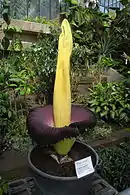 First of two plants, Kew Gardens, London, May 1, 2009
First of two plants, Kew Gardens, London, May 1, 2009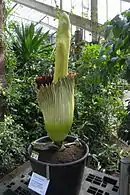 Second of two plants, Kew Gardens, London, May 1, 2009
Second of two plants, Kew Gardens, London, May 1, 2009 "Morticia", Franklin Park Zoo, Boston, Massachusetts, USA, June 20, 2012
"Morticia", Franklin Park Zoo, Boston, Massachusetts, USA, June 20, 2012 Titan Arum, Royal Botanic Gardens, Melbourne, Victoria, Australia, December 27, 2012
Titan Arum, Royal Botanic Gardens, Melbourne, Victoria, Australia, December 27, 2012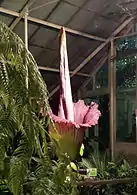 "Morty", Buffalo and Erie County Botanical Gardens, Buffalo, NY, USA, August 8, 2014
"Morty", Buffalo and Erie County Botanical Gardens, Buffalo, NY, USA, August 8, 2014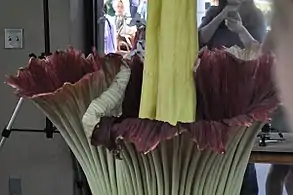 Huntington Library, San Marino, California August 24, 2014
Huntington Library, San Marino, California August 24, 2014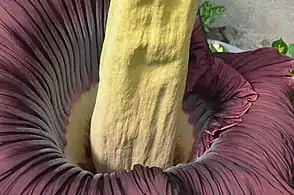 A. titanum close up, Bayreuth University, Germany, June 7, 2015
A. titanum close up, Bayreuth University, Germany, June 7, 2015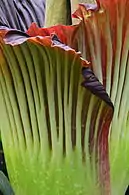 A. titanum close up, Bayreuth University, Germany, June 6, 2015
A. titanum close up, Bayreuth University, Germany, June 6, 2015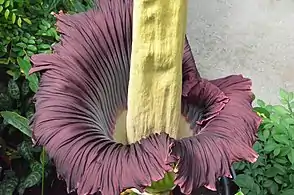 A. titanum, Bayreuth University, Germany, June 7, 2015
A. titanum, Bayreuth University, Germany, June 7, 2015 A. titanum close up, Bayreuth University, Germany, June 6, 2015
A. titanum close up, Bayreuth University, Germany, June 6, 2015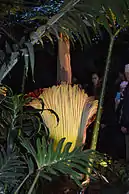 "Putrella", Muttart Conservatory, Edmonton, Canada, April 7, 2015
"Putrella", Muttart Conservatory, Edmonton, Canada, April 7, 2015 A. titanum leaflets, Muttart Conservatory, Edmonton, Canada
A. titanum leaflets, Muttart Conservatory, Edmonton, Canada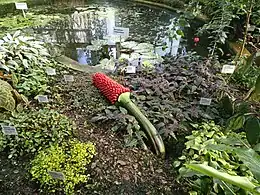 A. titanum with fruits, Liberec, Czech Republic
A. titanum with fruits, Liberec, Czech Republic.jpg.webp) A. titanum, Bogor Botanical Gardens
A. titanum, Bogor Botanical Gardens
References
- Yuzammi & Hadiah, J.T. (2018). "Amorphophallus titanum". IUCN Red List of Threatened Species. 2018: e.T118042834A118043213. doi:10.2305/IUCN.UK.2018-2.RLTS.T118042834A118043213.en.CS1 maint: uses authors parameter (link)
- Hodge, W.H. (1962). "A Titan Arum Flowers" (PDF). ahsgardening.org. Retrieved 2019-01-15.
- "Titan Arum Blooming". Events. UNC Charlotte Botanical Gardens. 2007. Retrieved 2008-10-28.
- "About titan arum Amorphophallus titanum" (PDF). Information sheetO10. Royal Botanic Gardens Kew. 2006. Archived from the original (PDF) on 2008-10-15. Retrieved 2008-10-26.
- "Titanenwurz — Bonner Blütenstände". 2013. Retrieved 2013-06-23.
- Gilford Steamer (newspaper) July 1, 2010 pp. A1 & A9.
- "Tallest bloom".
- McDonald, Charlotte. "Royal Botanic Garden Edinburgh – The story of our corm". www.rbge.org.uk. Retrieved 2017-07-14.
- University of Connecticut (14 Feb 2011). "Amorphophallus titanum". Archived from the original on 2012-05-02. Retrieved 17 February 2011.
- "Error 404 – Page Not Found". Cite uses generic title (help)
- Botanic Garden of the University of Bonn. "Official Homepage of the Botanic Garden". Archived from the original on 28 January 2008. Retrieved 2008-02-08.
- Tallest bloom. Guinness World Records.
- Koziol, J. 2010. "Corpse flower" makes Guinness record. Fosters, September 24, 2010.
- Eastern Illinois University's Three Titan Arum Blooms 2012 Retrieved 2013-08-11
- 'Big Bucky' 5/2009 and 6/2009, University of Wisconsin–Madison
- 'Big Bucky' 5/2012 and 'Little Stinker' 9/2009, University of Wisconsin–Madison
- University of Bonn Botanic Garden, Bonn, Germany Three blooms from one corm Retrieved 2013-08-11
- Eastern Illinois University's Three Titan Arum blooms 2012. Retrieved 2013-08-11
- Huntington Botanical Gardens, California Self-pollination Archived August 10, 2013, at the Wayback Machine. Retrieved 2013-08-11
- Gustavus Adolphus College Self-pollination 2011. Retrieved 2013-08-11
- "Titan Arum—FAQ | Chicago Botanic Garden". www.chicagobotanic.org. Retrieved 2015-10-01.
- American Chemical Society. The Chemistry of the Corpse Flower's Stench 2013
- Cornell University. What made 'Wee Stinky' stink. 2012. Retrieved 2013-08-11
- "Corpse Flower Cam: Watch Rosie Bloom in Real-Time from Tucson". 2018-04-23.
- "Tucson 'corpse flower' watch: Rosie is blooming". Arizona Daily Star.
- "Corpse Flower", Missouri Botanical Garden.
- "Live view – AXIS P1344 Network Camera".
- "Amorphophallus titanum".
- "Corpse Flower Live Stream". Conservatory of Flowers.
- "Meet java and Sumatra". Chicago Botanic Gardens.
- ""Wee Stinky" titan arum cam". Cornell Cast – Cornell University.
- "Corpse flower at NC State". College of Agriculture and Life Sciences.
- Pep le pew corpse flower bloom 2018
- Putricia blooms at Meijer Gardens
- "See it in person or watch online as Amazon's latest rare corpse flower is set to bloom inside Spheres". GeekWire. 2019-06-04. Retrieved 2019-06-06.
- "Watch Sprout Grow: Corpse Flower Livestream at Longwood Gardens". YouTube. Longwood Gardens. Retrieved 10 July 2020.
- https://www.youtube.com/watch?v=Rh_mfWhIlig
- Time-lapse Video of Titan Arum Bloom, July 2007, retrieved 2015-08-22
- Perry the Corpse Flower Full Bloom Cycle 2013, retrieved 2015-08-22
- Giant Corpse Flower bloom – time lapse from two views, retrieved 2015-08-26
- First flowering of Aaron
- "Amorphophallus titanum". Plants of the World Online. Royal Botanic Gardens, Kew. Retrieved 2015-09-13.
- "Timelapse flowering of the Titan arum at Mount Lofty Botanic Garden (first vision)". www.environment.sa.gov.au/botanicgardens/Home.
- "Thousands queue for whiff of Adelaide 'corpse flower'". ABC News. February 2016. Retrieved 2016-02-02.
- "Surprise corpse flower blooming creates suspected 'world first' at Adelaide Botanic Gardens". ABC News. 2017-01-03. Retrieved 2017-01-03.
- Geena Fowles (1 February 2016). "Stinky Flower Blooms in Minnesota". America Herald.
- "The Spadix Speaks: Cornell's Titan Arum Blog". Cornell University. Retrieved 2016-10-12.
- "Corpse flower blooming time lapse (titan arum) at Indiana University". YouTube. Retrieved 2018-04-30.
- "Meijer Gardens Corpse Flower Timelapse". YouTube. Retrieved 2018-08-13.
- "Titan Arum Time Lapse - Northwestern State University of Louisiana". YouTube. Retrieved 2020-07-04.
- "See Sprout Bloom!". YouTube. Longwood Gardens. Retrieved 20 July 2020.
Bibliography
- Bown, Deni (2000). Aroids: Plants of the Arum Family. Timber Press. ISBN 0-88192-485-7
- Association of Education and Research Greenhouse Newsletter, volume 15 number 1.
External links
| Wikimedia Commons has media related to Amorphophallus titanum. |
- Three Webcams of Titan plus time-lapse videos at Gustavus Adolphus College in Saint Peter, Minnesota
- 3D Photo of 2004 bloom at Walt Disney World (Requires red/cyan 3D Glasses)
- List of bloomings in the US since 1937
- How to grow a Titan Arum
- Titan Arum at the Flower Park Kagoshima of Kagoshima Prefecture, Japan (in Japanese)
- Amorphophallus titanum YouTube video
